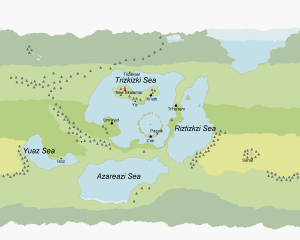Ouerea
| Unathi Lore Pages | ||
|---|---|---|
| Planet and System Page | Moghes · Ouerea | |
| Society and History Pages | Notable Unathi · Unathi Military Structure · Skalamar University Of Medicine · Contact War | |
Ouerea, which is the fourth planet from the Uueoa-Esa star, is the first planet to be colonized by the Unathi. It was successfully colonized with Jargon and Alliance assistance on February 3rd, 2438. Ouerea is one of two habitable planets in the system, the second being Moghes. The planet was discovered and accurate models of its position and orbit were made in 1483 by Izweski astronomer Kizar Yuiz'ku, and it was discovered to be habitable in the 20th century. In general the planet's biome is roughly similar to Moghes with mild variations. The ecosystem is a lot less complex than Moghes, with most of the planet covered in grasslands and forests with small, simplistic wildlife and fish. However these ecosystems are under threat by extensive and exhaustive mining operations being done by Hephaestus Industries.
Geography and Climate
Ouerea's biomes are less complex than Moghes, with most of the planet dominated by forests and grassland, and a single large desert between the Riztizkzi and Yuaz seas. Early surveys revealed a massive and complex underground cave network snaking across most of the planet, including large caverns and canyons. Most of these subterranean features are filled with water and host to a large variety of underwater wildlife. Izweski Rangers and Hephaestus survey teams continue to explore these cave networks but the vast majority of them remain unmapped and unexplored. The sheer size and depth of the caverns continue to perplex xeno-geologists. Hephaestus mining operations focus heavily on expanding and digging inside pre-existing cavern systems mapped by their teams.
The four major seas of Ouerea contribute to the planet's higher average humidity than Moghes. During Ouerea's Versakh season the humidity near the coast is high enough that Unathi that remain outside for extended periods can develop an irritating skin condition as an Ouerean-native mildew develops on their scales and hide. This mildew is extremely difficult to remove with normal bathing and must be treated with topical cream, and is deeply embarrassing for affected Unathi.
Year and seasons
A year on Ouerea is 510 days, and similar to Moghes the resident Unathi have divided the year into 15 months with 34 days each.
Versakh is the first season. It lasts 5 months and is typically marked with warm, wet weather and an average global temperature of 35°C. Culturally, like on Moghes, Versakh is a time of rejuvenation and relaxation. During Versakh it's completely acceptable for Unathi to take time off of work during the afternoon when the temperature is the hottest in order to nap or bask in the sun. This also marks the beginning of the typical hunting season, though on Ouerea this is more ceremonial.
Kasavakh is the second season. It lasts 5 months and usually brings cooler, wet weather with average global temperatures around 30°C. Kasavakh is regarded as a time of productivity and bounty. Kasavakh is typically the busiest time of the year for Unathi. During hot days Unathi are still permitted to take time off in the afternoons but doing it too much during Kasavakh makes them appear lazy.

Travakh is the third season which lasts 5 months and marks the end of a calendar year. It is the driest time of the year for most of Ouerea, with temperatures dropping to an average of 19°C until the beginning of Versakh. Travakh is regarded as a time of rest and contemplation. Holidays during the months of Travakh tend to focus on honoring and celebrating the family, both past and present, and tend to be in-door affairs. Outdoor activities tend to lull during this period.